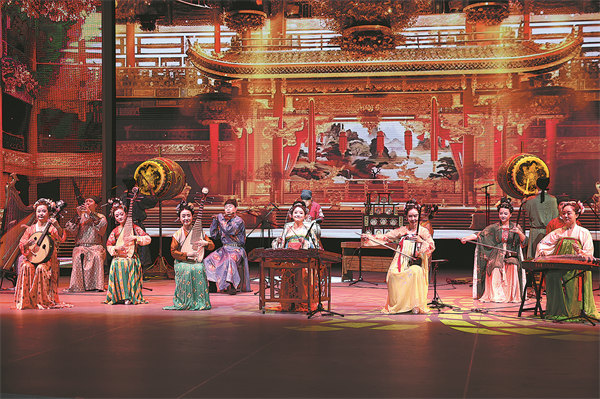
The China Pavilion, one of the most popular pavilions at Expo 2025 Osaka, has garnered widespread attention for its seamless integration of traditional culture and cutting-edge technology.
A large-scale cultural performance themed “Colorful China, Shaping the Future Together” was staged on July 11, featuring performers from China’s Shaanxi province who presented traditional culture through classical instrument performances, martial arts, and acrobatics.
China Pavilion Day drew over 400 attendees, including representatives from China, Japan, and delegates from other national pavilions and friendship organizations.
The show presented a vision rooted in China’s ecological philosophy and civilizational values that resonated with visitors across sectors.
In his remarks at the ceremony, Japanese Minister of Economy, Trade and Industry Yoji Muto noted that the pavilion creatively combines heritage and innovation while also illustrating the long, historical relationship between China and Japan.
“I hope the presentation will deepen the understanding of China among people in Japan and the world,” he said.
Masayoshi Matsumoto, chairman of the Kansai Economic Federation, says that the pavilion offers a comprehensive view of China’s culture, history and advanced technology, which deepens visitors’ understanding of China’s dynamic development.
They also hope that more visitors will explore the pavilion and experience China’s rich heritage and modern vitality firsthand.
A highlight for many guests was the corridor that connects the pavilion’s two floors, which features animated Chinese ink paintings on one side and wooden reliefs capturing iconic moments in China-Japan cultural exchange on the other side.

From the friendship between Chinese poet Li Bai and Japanese scholar Abe no Nakamaro, also known as Chao Heng, in the Tang Dynasty (618-907) to the arrival of pandas Kang Kang and Lan Lan, joint efforts in ibis conservation, and the symbolic pairing of Sun Wukong, the Monkey King, with Astro Boy, the display underscores China’s values of harmony and neighborliness to the Osaka audience.
Michiko Ogawa, the executive director of Panasonic Holdings, says she was particularly moved by the corridor’s artistic storytelling. “It reflects the deep, multilayered ties between our two countries,” she says.
Akio Aoyagi, president of the Osaka Japan-China Friendship Association, says the pavilion’s vivid visuals and soundscape made its messages memorable. “Though I’ve been to China many times, this reminded me how much more there is to learn. I hope exchanges like this continue to grow.”
A visitor named Morita from Hyogo Prefecture says it was her second visit to the pavilion. “It’s large, beautifully designed, and rich in content. It’s one of my favorite national pavilions,” she says.
The expo runs from April 13 to Oct 13, with the theme “Designing Future Society for Our Lives”.
The China Pavilion, one of the largest foreign self-built pavilions, spans approximately 3,500 square meters. Inspired by traditional Chinese calligraphy scrolls, the pavilion’s design embodies the theme of “Building a Community of Life for Man and Nature — Future Society of Green Development”.








